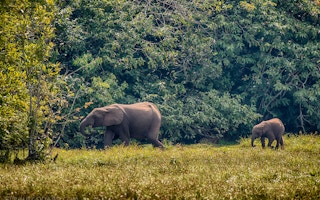In late January and early March, a huge fire ripped through the forests of the Republic of Congo. Satellite data show it totaled more than 15,000 hectares (150 square kilometers), making the fire one of the largest ever observed in Central Africa’s rainforests. A research organization says El Niño is largely to blame, but that human activities in the region may also have exacerbated the situation.
The Congo Basin occupies much of the middle of the African continent, straddling the equator from Gabon to Uganda, Cameroon to Angola. At 200 million hectares, the Congo Basin rainforest is second only to the Amazon in size, and provides habitat for endangered animals found nowhere else such as bonobos, gorillas, and okapi.
The Republic of Congo, often simply referred to as “Congo,” contains some of the largest tracts of intact rainforest left in Africa. It was right in the middle of these that satellites recently detected a huge wildfire – along with several nearby smaller fires. Data from NASA show a big jump in fire alerts starting on January 28, spreading rapidly outward until around February 4. Tree cover loss alerts from the University of Maryland’s Global Land Analysis and Discovery (GLAD) project show resultant forest loss extend well into a tract of Intact Forest Landscape that had been undisturbed as of 2013. (Intact Forest Landscapes (IFLs) are areas of primary forest that are large and pristine enough to retain their original levels of biodiversity.)
Unlike forests like those in Australia and western North America that have evolved in concert with wildfire for millennia, rainforests are not adapted to burn. Congo’s rainforests are no exception to this rule, and researchers are attributing this most recent near-record-breaking fire to the El Niño event that is upsetting weather patterns around the world. For Africa, its effects have been particularly severe. Droughts in the southern portion of the continent are having a “devastating” impact on the region’s food security, according to the UN Food and Agriculture Organizations (FAO). A similar situation is being felt in east-central Africa, as unpredictable rainfall is whittling away forests and crop fields alike.
In northern Congo, where the soil is porous and the forest depends on regular and frequent rain, the situation came to a head in late January with the break out of one massive fire and several smaller ones. But GLAD representatives say El Nino may not be solely to blame for the fires. They point a finger (or more literally, a Facebook post) at the timber industry, which has been a growing presence in the region.
“It is likely that these fires were human-induced, as multiple instances of forest fire occurred along or near roads,” states a post on GLAD’s Facebook page.
However, Fai Collins, Communications Officer for the Center of International Forestry Research (CIFOR) told Mongabay that logging road-induced fires are “not common in the region.” Collins said paths are cleared along roads in areas where the fire risk is high to remove flammable debris and reduce the risk of fire.
The tract of forest in which the largest of the fires occurred is host to Industrie Forestière d’Ousso, a subsidiary of the Danzer Group, an international supplier of timber products. The forests managed and selectively logged by IFO are certified by the Forestry Stewardship Council (FSC), which sets sustainability standards for the timber industry.
When contacted by Mongabay, an FSC representative said that the organization is currently looking into what led to the fires, and how the Danzer Group is planning to prevent future fires. Danzer did not respond to multiple requests for comment.
In their post, the GLAD team warns if the conditions that led to the fires continue, more outbreaks could happen in the future – and that would be bad news for Congo’s rainforest and wildlife.
“Increasing frequency and severity of drought would possibly lead to more fire in Congo Basin rainforests,” the team writes. “Given that Republic of Congo contains some of the largest remaining expanses of intact humid tropical forest and associated large mammal habitat, fires such as those observed in the GLAD alerts represent a threat to the maintenance of this ecosystem.”
This story was published with permission from Mongabay.com.

















